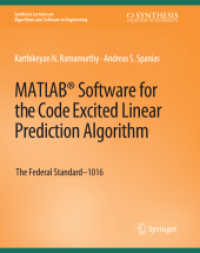Full Description
Are you struggling to get your head around John Dewey's educational pragmatism? What exactly is Jean Piaget saying about cognitive development? Maybe you're running out of time and patience making sense of Rosenshine's Principles of Instruction? Have you reached breaking point reading Daniel T. Willingham on educational neuroscience?
Written for busy teachers, students, trainers, managers and , this 'dip-in, dip-out' guide makes theories of learning accessible and practical. It explores 134 classic and contemporary learning theorists in an easy-to-use, bite-sized format with clear relevant illustrations on how each theory will benefit teaching and learning.
Each model or theory is explained in less than 350 words, followed by a 'how to use it' section.
New to this third edition:
New section on cognitive learning theory, including Arthur Shimamura, Alison Gopnik, John Flavell and more
Enhanced critical perspectives offering a deeper examination of each theory's strengths and weaknesses
A new entry on Gloria Ladson-Billings and Critical Race Theory in education
Contents
PART 1: CLASSICAL LEARNING THEORIES
Section 1.1: Educational Philosophy
Section 1.2: Behaviourism
Section 1.3: Cognitivism
Section 1.4: Humanism
Section 1.5: Educational Neuroscience
PART 2: CONTEMPORARY THINKING ON TEACHING AND LEARNING
Section 2.1: Professionalism
Section 2.2: Cognitive Learning Theory
Section 2.3: Motivation
Section 2.4: Behaviour Management
Section 2.5: Coaching and Mentoring
Section 2.6: Teamworking
PART 3: AN INTRODUCTION TO EARLY CHILDHOOD AND DEVELOPMENTAL STRATEGIES
Section 3.1: Children and Society
Section 3.2: Emotional Growth
Section 3.3: Classroom Strategies
Section 3.4: Working with Children with Additional Needs
Section 3.5: Different School Approaches
PART 4: PLANNING, DELIVERING AND ASSESSING LEARNING
Section 4.1: Curriculum Planning
Section 4.2: Lesson Planning
Section 4.3: Delivering Learning
Section 4.4: Assessment and Feedback
Section 4.5: Evaluating Teaching and Learning
A final word on TEACHING








